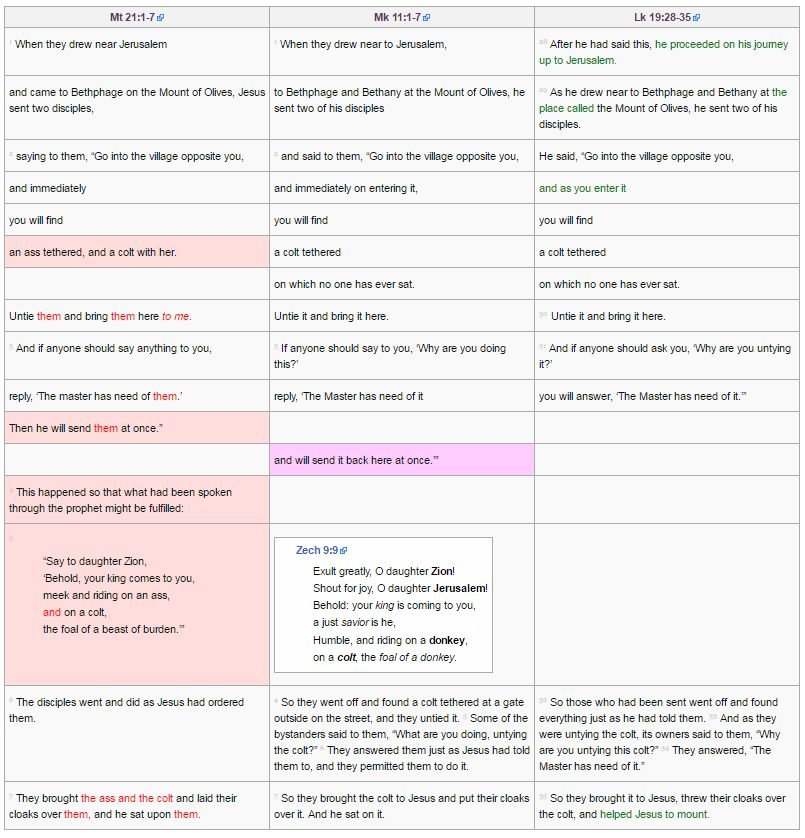The Donkey and the Colt: Difference between revisions
No edit summary |
No edit summary |
||
| Line 68: | Line 68: | ||
|- valign="top" | |- valign="top" | ||
|<!-- Mt --> <sup class="versenum">6</sup> The disciples went and did as Jesus had ordered them. | |<!-- Mt --> <sup class="versenum">6</sup> The disciples went and did as Jesus had ordered them. | ||
|<!-- Mk --> <sup class="versenum">4</sup> So they went off and found a colt tethered at a gate outside on the street, and they untied it. | |<!-- Mk --> <sup class="versenum">4</sup> So they went off and found a colt tethered at a gate outside on the street, and they untied it.<sup class="versenum">5</sup> Some of the bystanders said to them, “What are you doing, untying the colt?†<sup class="versenum">6</sup> They answered them just as Jesus had told them to, and they permitted them to do it. | ||
<sup class="versenum">5</sup> Some of the bystanders said to them, “What are you doing, untying the colt?†| |||
<sup class="versenum">6</sup> They answered them just as Jesus had told them to, and they permitted them to do it. | |||
|<!-- Lk --> | |<!-- Lk --> | ||
|- valign="top" | |- valign="top" | ||
Revision as of 04:44, 29 May 2016
| Mt 21:1-7 | Mk 11:1-7 | Lk 19:28-35 |
|---|---|---|
| 1 When they drew near Jerusalem | 1 When they drew near to Jerusalem, | After he had said this, he proceeded on his journey up to Jerusalem. |
| and came to Bethphage on the Mount of Olives, Jesus sent two disciples, | to Bethphage and Bethany at the Mount of Olives, he sent two of his disciples | |
| 2 saying to them, “Go into the village opposite you, | 2 and said to them, “Go into the village opposite you, | |
| and immediately | and immediately on entering it, | |
| you will find an ass tethered, and a colt with her. | you will find | you will find |
| an ass tethered, and a colt with her. | a colt tethered | |
| on which no one has ever sat. | on which no one has ever sat. | |
| Untie them and bring them here to me. | Untie it and bring it here. | |
| 3 And if anyone should say anything to you, | 3 If anyone should say to you, ‘Why are you doing this?’ | |
| reply, ‘The master has need of them.’ | reply, ‘The Master has need of it | |
| Then he will send them at once.†| ||
| and will send it back here at once.’†| ||
| 4 This happened so that what had been spoken through the prophet might be fulfilled: | ||
5
|
||
| 6 The disciples went and did as Jesus had ordered them. | 4 So they went off and found a colt tethered at a gate outside on the street, and they untied it.5 Some of the bystanders said to them, “What are you doing, untying the colt?†6 They answered them just as Jesus had told them to, and they permitted them to do it. | |
| 7 They brought the ass and the colt and laid their cloaks over them, | 7 So they brought the colt to Jesus and put their cloaks over it. | |
| and he sat upon them. | And he sat on it. |
Zechariah 9:9 uses Hebrew poetic parallelism four times:
- Exult greatly, O daughter Zion!
- Shout for joy, O daughter Jerusalem!
- Behold: your king is coming to you,
- a just savior is he,
- Humble, and riding on a donkey,
- on a colt, the foal of a donkey.
- - Zion is Jerusalem.
- - The king is the just savior.
- - The donkey is a colt.
- - The colt is the foal of a donkey.
In all four cases, the same reality is being described from two different points of view. There is no question that in the Hebrew of Zechariah, the king is not pictured riding two different animals (a donkey and a colt), but just one. Matthew's gospel places a peculiar interpretation on the verse and pictures Jesus perched on two animals of different ages or dismounting and remounting en route. This suggests that the original author of the gospel or else the final editor of the gospel was not very familiar with Hebrew poetry.
Legend: Matthew first written in Aramaic, then translated into Greek. If true, we do not have the original. Syriac: "they put their garments on the colt, and Jesus rode on it."
The final "them" in Matthew could refer to the garments rather than the animals.
